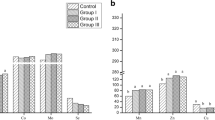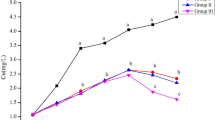Abstract
In recent decades, the groundwater contaminated by mineral development and metal smelting has seriously polluted natural grasslands, resulting in heavy metal residues in soils and forages exceeding the standard, especially copper (Cu) and cadmium (Cd). After animals intake contaminated forages, heavy metals may accumulate in animal tissues and threaten human health through the food chain. Previous studies found that molybdenum (Mo) fertilizer from ammonium molybdate or potassium molybdate could alleviate the decrease of antioxidant capacity caused by heavy metal poisoning, but the application of nano-Mo fertilizer in sheep is still lacking. To investigate the effects of nano-Mo fertilizer on Cu metabolism of grazing Chinese Merino sheep (Junken Type) on natural pastures under Cu and Cd stress, fertilizing experiment was carried out in the Bayanbulak Grassland in the northwest of Xinjiang Uygur Autonomous Region, China. A total of 24 hm2 fenced grassland contaminated by heavy metals was randomly divided into four groups (3 replications/group and 2 hm2/replication). The experimental groups were applied 0 g Mo, 100 g Mo, 200 g Mo, and 300 g Mo per hectare for the control group, group I, group II, and group III, respectively, through foliar spraying fertilization. A total of 72 Chinese Merino sheep (1 year old, 43.8 ± 2.3 kg) grazing on polluted natural grasslands, with 18 sheep per group, were randomly assigned to the experimental pastures for 30 days. The results showed that the Mo content in soil in group II and group III nwas higher than that in the control group (P < 0.05); the Cd content in soil in group II and group III was lower than that in the control group (P < 0.05), and the Cu content in soil in fertilized pastures was lower than that in the control group (P < 0.05). The Mo content in herbage in fertilized pastures was higher than that in the control group (P < 0.05), and the content of Cu in herbage in fertilized pastures was lower than that in the control group (P < 0.05). The contents of iron (Fe) and Mo in blood and liver of grazing animals from fertilized pastures were higher than that in the control group (P < 0.05). The Cd content in blood of grazing animals in group II and group III was lower than that in the control group (P < 0.05). The Cu content in blood and liver of grazing animals in fertilized pastures was lower than that in the control group (P < 0.05). The content of selenium (Se) in blood of grazing animals in group II and group III was higher than that in the control group (P < 0.05). The levels of blood including hemoglobin (Hb), erythrocyte count (RBC), and packed cell volume (PCV) in group II and group III were higher than that in the control group (P < 0.05). The white blood cell (RBC) count in group II and group III was lower than that in the control group (P < 0.05). The activities of serum superoxide dismutase (SOD), glutathione peroxidase (GSH-Px), catalase (CAT), and ceruloplasmin (Cp) in group II and group III were higher than that in the control group (P < 0.05). The content of malondialdehyde (MDA) in group II and group III was lower than that in the control group (P < 0.05). In conclusion, the application of nano-Mo fertilizer on Cu- and Cd-contaminated grasslands changed the contents of mineral elements in soil, forage, and blood of grazing sheep, improved the antioxidant capacity, affected the Cu metabolism of grazing Chinese Merino sheep caused by Cu and Cd pollutions, and alleviated the toxic damage of heavy metal pollutions.
Similar content being viewed by others
Data Availability
The datasets generated during and/or analyzed during the current study are available from the corresponding author on reasonable request.
References
Gao JQ, Yu Y, Wang DH, Liu LJ (2019) The content and distribution characteristics of heavy metals in root soils in the Jiajika Lithium resource area. Western Sichuan Province Rock Min Analy 38(6):381–392
Du J, Wang ZK, Liu J, Zhong SQ, Wei CF (2020) Distribution characteristics of soil heavy metals, their source identification and their changes influenced by anthropogenic cultivation activities in purple hilly regions of Sichuan Basin. China J Soil Sci Plant Nutr 20(3):1080–1091
Zhao XG, Li ZL, Wang DL, Li J, Zou B, Tao Y, Lei LM, Qiao FY, Huang J (2019) Assessment of residents’ total environmental exposure to heavy metals in China. Sci Rep 9(1):16386
Wu P, Jiang LY, He Z, Song Y (2017) Treatment of metallurgical industry wastewater for organic contaminant removal in China: status, challenges, and perspectives. Environ Sci Wat Res Technol 3(6):1017–1031
Reis LSLS, Pardo PE, Camargos AS, Oba E (2010) Mineral element and heavy metal poisoning in animals. J Med Med Sci 1(12):560–579
Li YF, Shen XY, Liu FY, Luo L, Wang, YC (2021) Molybdenum fertilization improved antioxidant capacity of grazing Nanjiang brown goat on copper-contaminated pasture. Biol Trace Elem Res. https://doi.org/10.1007/s12011-021-02735-w
Chen JQ, Xu YM, Han Q, Yao YC, Xing HJ, Teng XH (2019) Immunosuppression, oxidative stress, and glycometabolism disorder caused by cadmium in common carp (Cyprinus carpio L.): application of transcriptome analysis in risk assessment of environmental contaminant cadmium. J Hazard Mater 366:386–394
Li HX, Ji HB, Shi CJ, Gao Y, Zhang Y, Xu XY, Ding HJ, Tang L, Xing YX (2017) Distribution of heavy metals and metalloids in bulk and particle size fractions of soils from coalmine brownfield and implications on human health. Chemosphere 172:505–515
Zhou SH, Zhang CY, Xiao QY, Zhuang Y, Gu XL, Yang F, Xing CH, Hu GL, Cao HB (2016) Effects of different levels of molybdenum on rumen microbiota and trace elements changes in tissues from goats. Biol Trace Elem Res 174(1):85–92
Li YF, He J, Luo L, Wang YC (2021) The combinations of sulfur and molybdenum fertilization improved antioxidant capacity in grazing Nanjiang brown goat. Biol Trace Elem Res. https://doi.org/10.1007/s12011-021-02702-5
Li YF, Wang YC, Shen XY, Liu FY (2021) The combinations of sulfur and molybdenum fertilizations improved antioxidant capacity of grazing Guizhou semi-fine wool sheep under copper and cadmium stress. Ecotox Environ Saf 222:112520
Song CJ, Gan SQ, He J, Shen XY (2021) Effects of nano-zinc on immune function in Qianbei-pockmarked goats. Biol Trace Elem Res 199(2):578–584
Shen XY, Huo B, Gan SQ (2020) Effects of nano-selenium on antioxidant capacity in Se-deprived Tibetan Gazelle (Procapra picticaudata) in the Qinghai-Tibet Plateau. Biol Trace Elem Res 199(3):981–988
Li YF, He J, Shen XY (2020) Effects of nano-selenium poisoning on immune function in the Wumeng semi-fine wool sheep. Biol Trace Elem Res 199(8):2919–2924
Huo B, Wu T, Chi YK, Ming XY, Shen XY (2019) Effects of molybdenum fertilizer application on copper metabolism of Wumeng semi-fine wool sheep in copper polluted grassland. J Dom Anim Ecol 40(7):44–49
Li YF, Wang YC, Shen XY (2021) Effects of sulfur fertilization on antioxidant capacity of Wumeng semi-fine wool sheep in the Wumeng Prairie. Pol J Environ Stud. https://doi.org/10.15244/pjoes/132792
Bao SD (2000) Soil agrochemical analysis [M]. China Agricultural Publishing House, Beijing, pp 22–42
GB 15618–2018. Soil environmental quality risk control standard of soil contamination of agricultural land (trial). Beijing, Ministry of Ecology and Environment of the People’s Republic of China
Khan ZI, Ahmad K, Ashraf I, Khan A, Fardous A, Sher M, Akram NA, Ashraf M, Hayat Z, Laudadio V, Tufarelli V, Hussain A, Arshad F, Cazzato E (2016) Appraisal of trace metal elements in soil, forage and animal continuum: a case study on pasture irrigated with sewage water. Philipp Agric Sci 99(1):80–87
Chi YK, Zhang ZZ, Song CJ, Xiong KN, Shen XY (2020) Effects of fertilization on physiological and biochemical parameters of Wumeng sheep in China’s Wumeng Prairie. Pol J Environ Stud 29(1):79–85
Soetan KO, Olaiya CO, Oyewole OA (2020) The importance of mineral elements for humans, domestic animals and plants-a review. Afr J Food Sci 4(5):200–222
Kan XQ, Dong YQ, Feng L, Zhou M, Hou HB (2021) Contamination and health risk assessment of heavy metals in China’s lead-zinc mine tailings: a meta-analysis. Chemosphere 267:128909
Pott EB, Henry PR, Zanett MA, Rao PV, JrEJ H, Ammerman CB (1999) Effects of high dietary molybdenum concentration and duration of feeding time on molybdenum and copper metabolism in sheep. Anim Feed Sci Technol 79(1–2):93–105
Heidari AH, Zamiri MJ, Nazem MN, Shirazi MRJ, Akhlaghi A, Pirsaraei ZA (2021) Detrimental effects of long-term exposure to heavy metals on histology, size and trace elements of testes and sperm parameters in Kermani sheep. Ecotox Environ Saf 207:111563
Nishito Y, Kambe T (2018) Absorption mechanisms of iron, copper, and zinc: an overview. J Nutr Sci Vitam 6(1):1–7
Zhang D (2015) Cadmium poisoning and mechanism of zinc on cadmium poisoning. Huazhong Agricultural University, Wuhan
Chen JQ, Zhang S, Tong JY, Teng XJ, Zhang ZY, Li S, Teng XH (2020) Whole transcriptome-based miRNA-mRNA network analysis revealed the mechanism of inflammation-immunosuppressive damage caused by cadmium in common carp spleens. Sci Total Environ 717:137081
Li Z, Shah SWA, Zhou Q, Yin XJ, Teng XH (2021) The contributions of miR-25–3p, oxidative stress, and heat shock protein in a complex mechanism of autophagy caused by pollutant cadmium in common carp (Cyprinus carpio L.) hepatopancreas. Environ Pollut 287:117554
Liu LL, Yang BY, Cheng YP, Lin HJ (2015) Ameliorative effects of selenium on cadmium-induced oxidative stress and endoplasmic reticulum stress in the chicken kidney. Biol Trace Elem Res 167(2):308–319
Feng Y (2020) Effect of hydroxyapatite on cadmium immobilization and rhizosphere microbial diversity in cadmium contaminated soil. Hebei University, Baoding
Chen JQ, Chen DC, Li JX, Liu YL, Gu XH, Teng XH (2021) Cadmium-induced oxidative stress and immunosuppression mediated mitochondrial apoptosis via JNK-FoxO3a-PUMA pathway in common carp (Cyprinus carpio L.) gills. Aquat Toxicol 233:105775
Shen XY, Song CJ (2021) Responses of Chinese Merino sheep (Junken Type) on copper-deprived natural pasture. Biol Trace Elem Res 199(3):989–995
Zhao K, Chi YK, Shen XY (2020) Studies on edema pathema in Hequ horse in the Qinghai-Tibet plateau. Biol Trace Elem Res 198(1):142–148
Shen XY, Min XY, Zhang SH, Song CJ, Xiong KN (2020) Effect of heavy metal contamination in environment on antioxidant function in Wumeng semi-fine wool sheep in the southwest China. Biol Trace Elem Res 198(2):505–514
Iqra B, Moolachand M, Pershotam K, Saeed AS, Hira S (2019) Effect of dietary selenium yeast supplementation on morphology and antioxidant status in tests of young goat. Pak J Zool 51:979–988
Zhao K, Huo B, Shen XY (2020) Studies on antioxidant capacity in selenium-deprived the Choko yak in the Shouqu prairie. Biol Trace Elem Res 199(9):3297–3302
Shen XY, Huo B, Li YF, Song CJ, Wu T, He J (2021) Response of the critically endangered Przewalski’s gazelle (Procapra przewalskii) to selenium deprived environment. J Proteom 241:104218
Jiao WY, Han Q, Xu YM, Jiang HJ, Xing HJ, Teng XH (2019) Impaired immune function and structural integrity in the gills of common carp (Cyprinuscarpio L.) caused by Chlorpyrifos exposure: through oxidative stress and apoptosis. Fish Shellfish Immun 86:239–245
Funding
This work was supported by the Innovation and Development Supporting Plan Project of Key Industries in Southern Xinjiang, China (2021DB014).
Author information
Authors and Affiliations
Contributions
Yuanfeng Li: Conceptualization, Methodology, Preparation, Investigation, Software, Data curation, Formal analysis, Writing—original draft; Jian He: Preparation, Investigation, Software, Data curation, Formal analysis, Writing—original draft; Xiaoyun Shen: Supervision, Conceptualization, Methodology, Investigation, Project administration, Funding acquisition, Resources, Writing-reviewing and editing; Kui Zhao: Supervision, Conceptualization, Methodology, Visualization, Investigation, Formal analysis.
Corresponding author
Ethics declarations
Ethics Approval
The protocol for the present experiment was approved by the Institutional Animal Care and Use Committee of Southwest University of Science and Technology (SWUST20210149).
Conflict of Interest
The authors declare no competing interests.
Additional information
Publisher's Note
Springer Nature remains neutral with regard to jurisdictional claims in published maps and institutional affiliations.
Rights and permissions
About this article
Cite this article
Li, Y., He, J., Shen, X. et al. Effects of Foliar Application of Nano-molybdenum Fertilizer on Copper Metabolism of Grazing Chinese Merino Sheep (Junken Type) on Natural Grasslands Under Copper and Cadmium Stress. Biol Trace Elem Res 200, 2727–2733 (2022). https://doi.org/10.1007/s12011-021-02889-7
Received:
Accepted:
Published:
Issue Date:
DOI: https://doi.org/10.1007/s12011-021-02889-7




